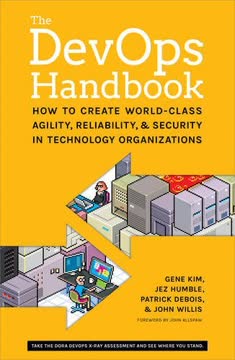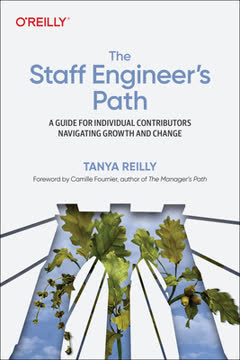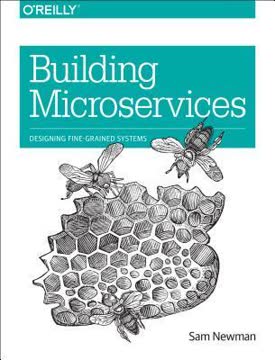Key Takeaways
1. Microservices: Small, autonomous services that work together
Microservices are small, autonomous services that work together.
Foundation of microservices. Microservices architecture is built on the principle of developing software as a suite of small, independent services. Each service is focused on doing one thing well, runs in its own process, and communicates via lightweight mechanisms like HTTP/REST APIs. This approach allows for greater flexibility, scalability, and maintainability compared to monolithic architectures.
Benefits and challenges. Key advantages of microservices include:
- Improved modularity
- Easier scaling of individual components
- Technology diversity
- Enhanced fault isolation
- Faster deployment cycles
However, microservices also introduce challenges such as:
- Increased operational complexity
- Distributed system concerns (e.g., network latency, fault tolerance)
- Data consistency across services
2. Evolutionary architecture: Adapting to changing requirements
The role of the architect is to look at the bigger picture, and understand this balance.
Embracing change. Evolutionary architecture emphasizes the need for systems to adapt to changing requirements over time. This approach recognizes that it's impossible to predict all future needs, so instead focuses on creating a flexible foundation that can evolve.
Key principles:
- Incremental change: Make small, frequent updates rather than large, infrequent ones
- Guided change: Use principles and practices to guide architectural decisions
- Multiple architectures: Recognize that different parts of the system may evolve at different rates
Architects in this model act more as town planners, setting guidelines and constraints, rather than dictating every detail. This allows teams to make local decisions while ensuring overall system cohesion.
3. Modeling services: Defining boundaries and contexts
We focus our service boundaries on business boundaries, making it obvious where code lives for a given piece of functionality.
Domain-driven design. Modeling services effectively requires a deep understanding of the business domain. Domain-driven design (DDD) provides valuable concepts for defining service boundaries:
- Bounded contexts: Areas of the domain with clear boundaries
- Ubiquitous language: A common language shared by developers and domain experts
- Aggregates: Clusters of domain objects treated as a unit
Identifying service boundaries:
- Align with business capabilities
- Encapsulate data and behavior
- Minimize dependencies between services
- Consider team structure and communication patterns
Well-defined boundaries lead to more cohesive services and looser coupling between them, facilitating independent development and deployment.
4. Integration strategies: Choosing the right approach for communication
Be conservative in what you do, be liberal in what you accept from others.
Importance of integration. Effective integration is crucial for microservices to work together seamlessly. The choice of integration technology significantly impacts system flexibility, performance, and maintainability.
Key integration patterns:
- Synchronous communication: REST, gRPC
- Asynchronous communication: Message queues, event streaming
- API gateways: For request routing and composition
- Service mesh: For handling service-to-service communication
Best practices:
- Use technology-agnostic protocols (e.g., HTTP)
- Implement tolerant readers to handle changes gracefully
- Design for failure with circuit breakers and bulkheads
- Consider event-driven architectures for loose coupling
The right integration strategy depends on your specific use case, performance requirements, and team expertise.
5. Splitting the monolith: Transitioning to microservices
Think of our monolith as a block of marble. We could blow the whole thing up, but that rarely ends well. It makes much more sense to just chip away at it incrementally.
Incremental approach. Transitioning from a monolithic architecture to microservices is best done gradually. This allows teams to learn and adapt while minimizing risk.
Steps for splitting a monolith:
- Identify seams in the existing codebase
- Extract bounded contexts into separate modules
- Refactor shared data structures and databases
- Create APIs for inter-module communication
- Extract modules into separate services
- Implement new features as microservices
Challenges to consider:
- Data dependencies between services
- Transactional integrity across service boundaries
- Performance impact of network communication
- Operational complexity of managing multiple services
Start with the easiest, least risky extractions to build confidence and experience before tackling more complex parts of the system.
6. Deployment techniques: Ensuring reliability and scalability
If doing something is right but difficult, we should strive to make things easier.
Automated deployment. Reliable and scalable deployment is critical for microservices success. Continuous Integration and Continuous Delivery (CI/CD) practices are essential for managing the increased deployment complexity.
Key deployment techniques:
- Infrastructure as Code (IaC)
- Containerization (e.g., Docker)
- Orchestration platforms (e.g., Kubernetes)
- Blue-green deployments
- Canary releases
Deployment considerations:
- Service discovery and configuration management
- Monitoring and logging
- Security and access control
- Database migrations and data consistency
Invest in tooling and automation to make deployments easier, faster, and more reliable. This enables teams to deploy frequently with confidence, realizing the full benefits of microservices architecture.
7. Testing microservices: Maintaining quality in a distributed system
The more moving parts, the more brittle our tests may be, and the less deterministic they are.
Comprehensive testing strategy. Testing microservices requires a multi-layered approach to ensure both individual service quality and overall system behavior.
Testing pyramid for microservices:
- Unit tests: Fast, focused tests for individual components
- Integration tests: Verify interactions between services
- Contract tests: Ensure services meet agreed-upon interfaces
- End-to-end tests: Validate entire system behavior
Testing challenges:
- Increased complexity due to distributed nature
- Managing test data across services
- Simulating production-like environments
- Handling asynchronous interactions
Emphasize fast feedback loops with unit and integration tests, while using fewer, carefully chosen end-to-end tests to validate critical paths. Consider using consumer-driven contracts to manage service dependencies effectively.
8. Monitoring and security: Keeping microservices healthy and protected
Good logging, and specifically the ability to aggregate logs from multiple systems, is not about prevention, but can help with detecting and recovering from bad things happening.
Holistic approach. Effective monitoring and security are crucial for maintaining a healthy microservices ecosystem. These aspects become more challenging and important in distributed systems.
Monitoring best practices:
- Centralized logging and log aggregation
- Distributed tracing (e.g., using correlation IDs)
- Real-time alerting and dashboards
- Application Performance Monitoring (APM)
- Synthetic monitoring for critical paths
Security considerations:
- Service-to-service authentication and authorization
- API gateways for edge security
- Secrets management
- Network segmentation
- Regular security audits and penetration testing
Implement a defense-in-depth strategy, securing both the perimeter and individual services. Use automation to ensure consistent application of security policies across all services.
9. Conway's Law: Aligning organization and system design
Conway's law highlights the perils of trying to enforce a system design that doesn't match the organization.
Organizational impact. Conway's Law states that system design mirrors communication structures within an organization. This principle has significant implications for microservices architecture.
Aligning teams and services:
- Organize teams around business capabilities
- Empower teams with end-to-end ownership of services
- Minimize cross-team dependencies
- Foster a culture of collaboration and shared responsibility
Considerations:
- Team size and composition
- Communication patterns and tools
- Decision-making processes
- Skill development and knowledge sharing
Recognize that organizational structure and system architecture are intertwined. Evolve both in tandem to create an environment conducive to successful microservices development and operation.
10. Scaling microservices: Handling growth and failure
At scale, even if you buy the best kit, the most expensive hardware, you cannot avoid the fact that things can and will fail.
Designing for scale and resilience. Microservices architectures must be designed to handle both growth in demand and inevitable failures gracefully.
Scaling strategies:
- Horizontal scaling (adding more instances)
- Vertical scaling (increasing resources per instance)
- Caching (in-memory, distributed)
- Database sharding and replication
- Asynchronous processing and event-driven architectures
Resilience patterns:
- Circuit breakers to prevent cascading failures
- Bulkheads for fault isolation
- Timeouts and retries with exponential backoff
- Graceful degradation of functionality
CAP theorem considerations:
- Consistency
- Availability
- Partition tolerance
Understand that trade-offs are necessary when scaling distributed systems. Prioritize based on your specific requirements and constraints. Implement observability and chaos engineering practices to continuously improve system resilience.
Last updated:
FAQ
What's Building Microservices by Sam Newman about?
- Microservices Architecture: The book explores microservices, which are small, autonomous services that collaborate to form a system. It highlights how this architecture can enhance software delivery speed and flexibility.
- Business Domain Focus: Microservices are modeled around business domains, aligning software design with business needs and avoiding issues of monolithic architectures.
- Practical Guidance: Sam Newman provides real-world examples from companies like Netflix and Amazon, offering a comprehensive guide for adopting or understanding microservices.
Why should I read Building Microservices by Sam Newman?
- Comprehensive Resource: It covers design, development, deployment, testing, and maintenance of microservices, making it ideal for those transitioning from monolithic systems.
- Real-World Examples: The book includes insights from organizations that have successfully implemented microservices, providing practical perspectives and lessons learned.
- Continuous Learning: It encourages embracing continuous learning to keep up with the fast-evolving nature of microservices technology and practices.
What are the key takeaways of Building Microservices by Sam Newman?
- Microservices Benefits: The book outlines benefits like improved scalability, resilience, and quick adoption of new technologies due to service autonomy.
- Loose Coupling and High Cohesion: Emphasizes designing services to be loosely coupled and highly cohesive, facilitating easier maintenance and updates.
- Integration Strategies: Discusses synchronous and asynchronous communication strategies, crucial for maintaining service autonomy and effective collaboration.
What is the definition of microservices according to Building Microservices by Sam Newman?
- Small, Autonomous Services: Defined as "small, autonomous services that work together," highlighting their independence and functionality without reliance on others.
- Business Functionality Focus: Each microservice handles a specific business capability, aligning with organizational goals and prioritizing work effectively.
- Decoupled Communication: Services communicate through well-defined APIs, maintaining loose coupling and enabling independent development and deployment.
How does Building Microservices by Sam Newman suggest modeling services?
- Bounded Contexts: Introduces bounded contexts from Domain-Driven Design to define service boundaries, with each context representing a specific responsibility.
- Loose Coupling and High Cohesion: Stresses that related functionality should reside within the same service, while unrelated functionality should be separated.
- Iterative Approach: Recommends refining service boundaries over time to accommodate changes in business requirements and technology.
What are the integration strategies discussed in Building Microservices by Sam Newman?
- Synchronous vs. Asynchronous: Contrasts synchronous communication, where a service waits for a response, with asynchronous communication, where services operate independently.
- Event-Driven Architecture: Advocates for event-driven architectures, where services emit events to signal state changes, promoting loose coupling.
- REST and RPC: Discusses RESTful APIs and Remote Procedure Calls for service communication, emphasizing technology-agnostic APIs for flexibility.
What are the challenges of deploying microservices as outlined in Building Microservices by Sam Newman?
- Increased Complexity: Warns of the complexity due to interdependencies between services, which can lead to deployment challenges without proper management.
- Continuous Integration and Delivery: Emphasizes robust CI/CD practices to manage microservices effectively, ensuring quick and reliable deployments.
- Monitoring and Management: Suggests comprehensive monitoring solutions to track the health and performance of each service independently.
How does Building Microservices by Sam Newman address testing in microservices?
- Types of Tests: Categorizes tests into technology-facing and business-facing, including unit, integration, and end-to-end tests for service reliability.
- Consumer-Driven Contracts: Introduces consumer-driven contracts to validate service interactions, ensuring changes in one service don't break dependent services.
- Automated Testing: Advocates for automated testing to maintain quality and speed in deployment, allowing confident release of changes.
What is the significance of Conway’s Law in Building Microservices by Sam Newman?
- Organizational Structure and Architecture: Discusses Conway’s Law, which states that system designs reflect the communication structures of organizations.
- Team Autonomy: Emphasizes organizing microservices around autonomous teams that own specific services, fostering accountability and ownership.
- Impact on Design: Highlights the importance of aligning team structures with service boundaries for effective collaboration and faster feature delivery.
What are the best quotes from Building Microservices by Sam Newman and what do they mean?
- Freedom to React: "Microservices give us significantly more freedom to react and make different decisions," highlighting agility compared to monolithic architectures.
- Service Autonomy: "The golden rule: can you make a change to a service and deploy it by itself without changing anything else?" emphasizes designing independent services.
- Postel's Law: "Be conservative in what you do, be liberal in what you accept from others," underscores flexibility in service interactions while maintaining strict internal standards.
What are some architectural safety measures discussed in Building Microservices by Sam Newman?
- Circuit Breakers: Prevent cascading failures by stopping further calls to a failing service, allowing it to recover without being overwhelmed.
- Bulkheads: Isolate different parts of a system to prevent a failure in one area from affecting others, enhancing resilience and stability.
- Timeouts: Setting appropriate timeouts for service calls to avoid hanging requests, ensuring services can fail fast and recover effectively.
How does Building Microservices by Sam Newman suggest handling service discovery?
- Dynamic Service Registries: Discusses using tools like Consul and Eureka for managing service discovery, allowing easy registration and discovery of services.
- DNS as a Solution: Mentions DNS for service discovery, though it may not suit highly dynamic environments, suggesting load balancers to mitigate limitations.
- Human-Friendly Interfaces: Emphasizes creating user-friendly interfaces for service discovery, aiding developers in finding and understanding available services.
Review Summary
Building Microservices receives mixed reviews, with many praising its comprehensive overview of microservices concepts and practical advice. Readers appreciate the author's cautious approach and real-world examples. Critics note the book's lack of depth on some topics and its potential to oversell microservices. Many find it valuable for beginners but less useful for experienced architects. The book covers various aspects of microservices, including design, deployment, testing, and scaling. Some readers wished for more concrete implementation details, while others valued its high-level perspective on software architecture.
Similar Books










Download PDF
Download EPUB
.epub digital book format is ideal for reading ebooks on phones, tablets, and e-readers.




